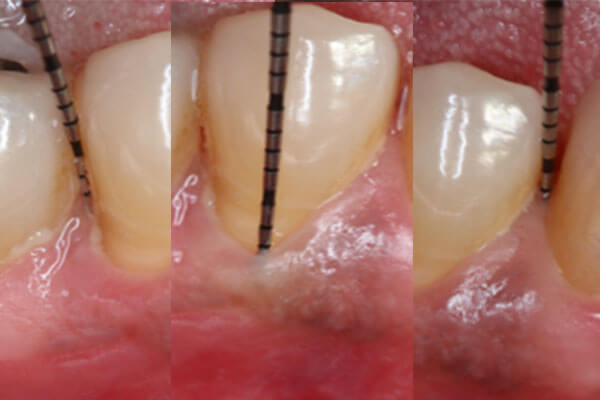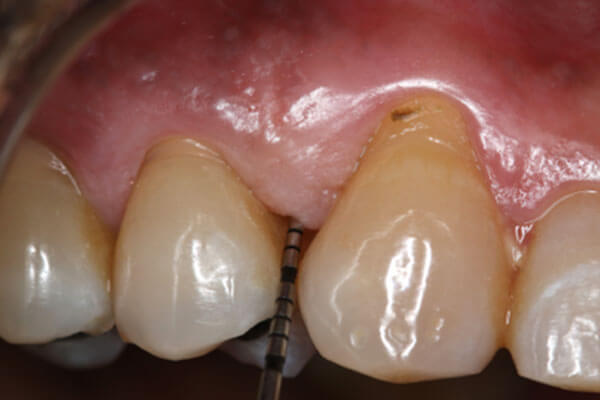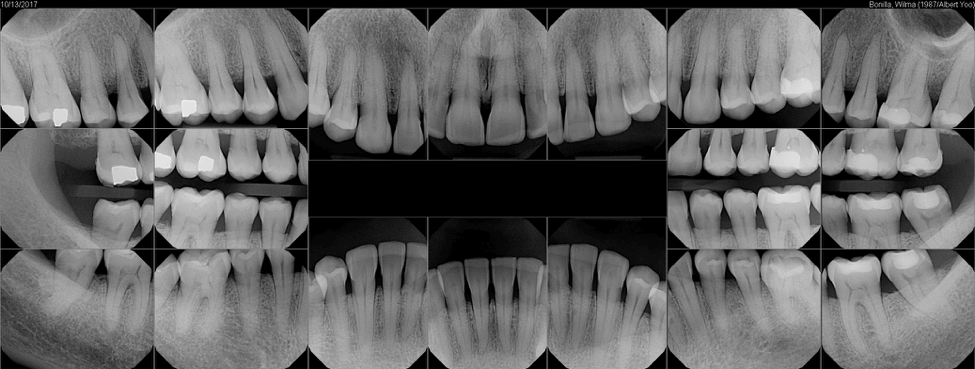Stages of Periodontal Disease

Periodontal Disease
Periodontal disease is the LEADING CAUSE OF TOOTH LOSS in the world (more than dental decay), with an estimated 60% of the world population suffering from some form of gum disease. Gum disease has two primary stages. If diagnosed and treated in the first stage, the condition can be reversed and tooth loss can usually be prevented. In order to prevent gum disease, practice good oral hygiene and visit your dentist for cleanings and check-ups regularly.
In your examination visit, a periodontal probe (small dental instrument) is gently used to measure the sulcus (pocket) between the tooth and the gums (figure 1). The depth of a healthy sulcus measures 3 millimeters or less and does not bleed.
As periodontal disease progresses, the pockets usually get deeper and bleeding becomes apparent, as the tissues are more inflamed (figure 2).
If gum disease is detected during your visit (diagnosis made with pocket depth measurements + xrays/radiographs), we will instruct you on steps regarding improved home care and recommend specialized treatment options in our office to eliminate the disease.
As periodontal disease progresses, the pockets usually get deeper and bleeding becomes apparent, as the tissues are more inflamed (figure 2).

Figure 1.
Normal probing depths around tooth. 6 measurements are taken around each tooth. 3 on the cheek side and 3 on the tongue/palate.
If gum disease is detected during your visit (diagnosis made with pocket depth measurements + xrays/radiographs), we will instruct you on steps regarding improved home care and recommend specialized treatment options in our office to eliminate the disease.

Figure 2.
Probing depth measuring 7mm indicative of bone loss around this tooth
Gingivitis – Early Stage of Gum Disease
This stage only affects the soft tissue of the gums, and the patient may not experience any discomfort. Although the symptoms may be very mild, it is important to diagnose gum disease in this early stage before it progresses to periodontitis.
Symptoms of Gingivitis may include:
- Swollen or bleeding gums
- Bad breath or a metallic taste in the mouth
Periodontitis – Advanced Stages of Gum Disease
Periodontitis is the name for more advanced periodontal disease and if permitted to progress to this point, not only the gums are affected but the bone structures supporting the teeth will be compromised. In addition to symptoms of gingivitis, signs that you have periodontitis may include:
- Receding gums
- Increasing spaces between teeth
- Loose teeth
- Gum pain
Without regular dental visits, symptoms may not be noticed until moderate periodontitis is present. Early diagnosis and treatment is imperative!!

Healthy Gums
Firm, pink, gums attached to the teeth and supported by firm dense bone are the indicators of healthy gums and teeth that have the strong support they need.

Gingivitis
A build-up of bacteria causes Gingivitis. In its early stages, inflammation around the gums is observable, with gum tissues appearing red and swollen. Gums that are easily irritated or that bleed during tooth brushing or flossing indicate the presence of Gingivitis. Removal of the plaque buildup is necessary to prevent the development/progression of gum disease.
Dental x-rays show normal bone levels in a patient with gingivitis.

Early Periodontitis
As the gums become more inflamed, they start to pull away from the teeth, forming spaces known as periodontal “pockets.” Food, bacteria, and plaque begin to collect in the pockets, leading to infection. The surrounding bone becomes damaged both by bacterial toxins and by the immune system’s response to infection.

Dental x-rays show minimal bone loss around the patient’s dentition.

Moderate Periodontitis
The symptoms of periodontitis become more severe as inflammation spreads, and some discomfort may occur. More supporting bone is lost, teeth loosen, and the gums recede further.
Dental x-rays show progressive bone loss around teeth.

Advanced Periodontitis
A major cause of tooth loss in adults, advanced periodontitis is marked by painful abscesses and severe bone loss that are the result of the infection spreading beneath the gums.
Dental x-rays show >50% bone loss around root surfaces of teeth with exposure of specific tooth anatomy (i.e. furcations of molars).